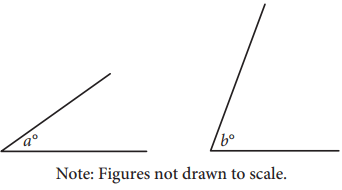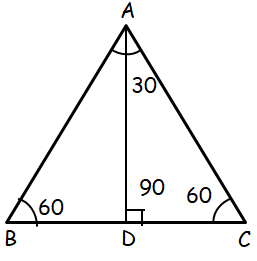MATCHING COEFFICIENTS OF POLYNOMIALS SAT QUESTIONS
Problem 1 :
If a ≠ 0,
what is the value of x ?
a) -5 b) -1 c) 1 d) 5
Solution :
Doing cross multiplication, we get
5(x + a) = x(5 + a)
5x + 5a = 5x + xa
Equating the coefficient of a, we get
5 = x
So, the value of x is 5.
Problem 2 :
If x + k = 12 and p(x + k) = 36, what is the value of p ?
(A) 3 (B) 4 (C) 6 (D) 9 (E) 12
Solution :
x + k = 12 ------(1)
p(x + k) = 36 ------(2)
Applying the value of x + k = 12 in (2), we get
p(12) = 36
p = 36/12
p = 3
Problem 3 :
y = a(x - 2)(x + 4)
In the quadratic equation above, a is a nonzero constant. The graph of the equation in the xy-plane is a parabola with vertex (c, d) . Which of the following is equal to d ?
A) −9a B) −8a C) −5a D) −2a
Solution :
y = a(x - 2)(x + 4)
Using distributive property,
y = a(x2 + 4x - 2x - 8)
y = a(x2 + 2x - 8)
y = a(x2 + 2 ⋅ x ⋅ 1 + 12 - 12 - 8)
y = a(x2 + 2 ⋅ x ⋅ 1 + 12 - 1 - 8)
y = a[(x + 1)2 - 9]
y = a(x + 1)2 - 9a
Comparing with y = a(x - h)2 + k
y = a(x - c)2 + d
d = -9a
Problem 4 :
The equation
true for all values x ≠ 2/a, where a is the constant. What is the value of a ?
a) -16 b) -3 c) 3 d) 16
Solution :
Equating the coefficient of x2, x and constants
-8a = 24 ------(1)
6 - 3a = 25 ------(2)
Continuing with (1), we get
a = -24/8
a = -3
So, the value of a is -3.
Problem 5 :

The angles shown above are acute and
sin(a°) = cos(b°)
If a = 4 − 22k and b = 6 − 13k, what is the value of k ?
Solution :
sin θ = cos (90 - θ)
Given,
sin(a°) = cos(b°)
sin(a°) = sin (90 - b°)
sin (4 - 22k) = sin (90 - (6 - 13k))
Equating angles, we get
4 - 22k = 90 - (6 - 13k))
4 - 22k = 90 - 6 + 13k
-22k - 13k = 84 - 4
-35k = 80
k = -80/35
k = -16/7
So, the value of k is -16/7.
Problem 6 :
In the xy-plane, the line determined by the points (2, k) and (k ,32) passes through the origin. Which of the following could be the value of k ?
A) 0 B) 4 C) 8 D) 16
Solution :
(2, k) and (k ,32)
Since the required line is passing through these two points, we can find slope of the line.
m = (y2 - y1) / (x2 - x1)
m = (32 - k) / (k - 2) ----(1)
Slope of the line passes through two points (2, k) and (0, 0)
m = (0 - k) / (0 - 2)
m = k/2 ----(2)
(1) = (2)
(32 - k) / (k - 2) = k/2
2(32 - k) = k(k - 2)
64 - 2k = k2 - 2k
k2 = 64
k = 8
Problem 7 :
tx + 12y = -3
The equation above is the equation of a line in the xy-plane, and t is a constant. If the slope of the line is 10, - what is the value of t ?
Solution :
tx + 12y = -3
12y = -tx - 3
y = -tx/12 - (3/12)
y = (-t/12)x - (1/4)
Slope of the line = 10
-t/12 = 10
-t = 10(12)
-t = 120
t = -120
So, the value of t is -120.
Problem 8 :
(-3x2 + 5x - 2) - 2(x2 - 2x - 1)
If the expression above is rewritten in the form ax2 + bx + c, where a, b, and c are constants, what is the value of b ?
Solution :
= (-3x2 + 5x - 2) - 2(x2 - 2x - 1)
= -3x2 + 5x - 2 - 2x2 + 4x + 2
= -5x2 + 9x
-5x2 + 9x = ax2 + bx + c
Comparing the corresponding terms,
a = -5, b = 9 and c = 0
So, the value of b is 9.
Problem 9 :
The perimeter of an equilateral triangle is 624 centimeters. The height of this triangle is k√3 centimeters, where k is a constant. What is the value of k?
Solution :
Perimeter of equilateral triangle = 624 centimeters
Let side length of the equilateral triangle be x
3x = 624
x = 624/3
x = 208

In triangle ADC,
AC = Hypotenuse = 208 = 2 (smaller side)
Let DC = Smaller side
2 DC = 208
DC = 208/2 ==> 104
AD = √3(Smaller side)
AD = √3(104)
AD = k√3
k = 104
So, the value of k is 104.
Problem 10 :
If a = 5√2 and 2a = √(2x), what is the value of x ?
Solution :
a = 5√2 and 2a = √(2x)
Applying the value of a, we get
2(5√2) = √(2x)
10√2 = √2 √x
√x = 10
Take square on both sides
x = 100
Recent Articles
-
Finding Range of Values Inequality Problems
May 21, 24 08:51 PM
Finding Range of Values Inequality Problems -
Solving Two Step Inequality Word Problems
May 21, 24 08:51 AM
Solving Two Step Inequality Word Problems -
Exponential Function Context and Data Modeling
May 20, 24 10:45 PM
Exponential Function Context and Data Modeling